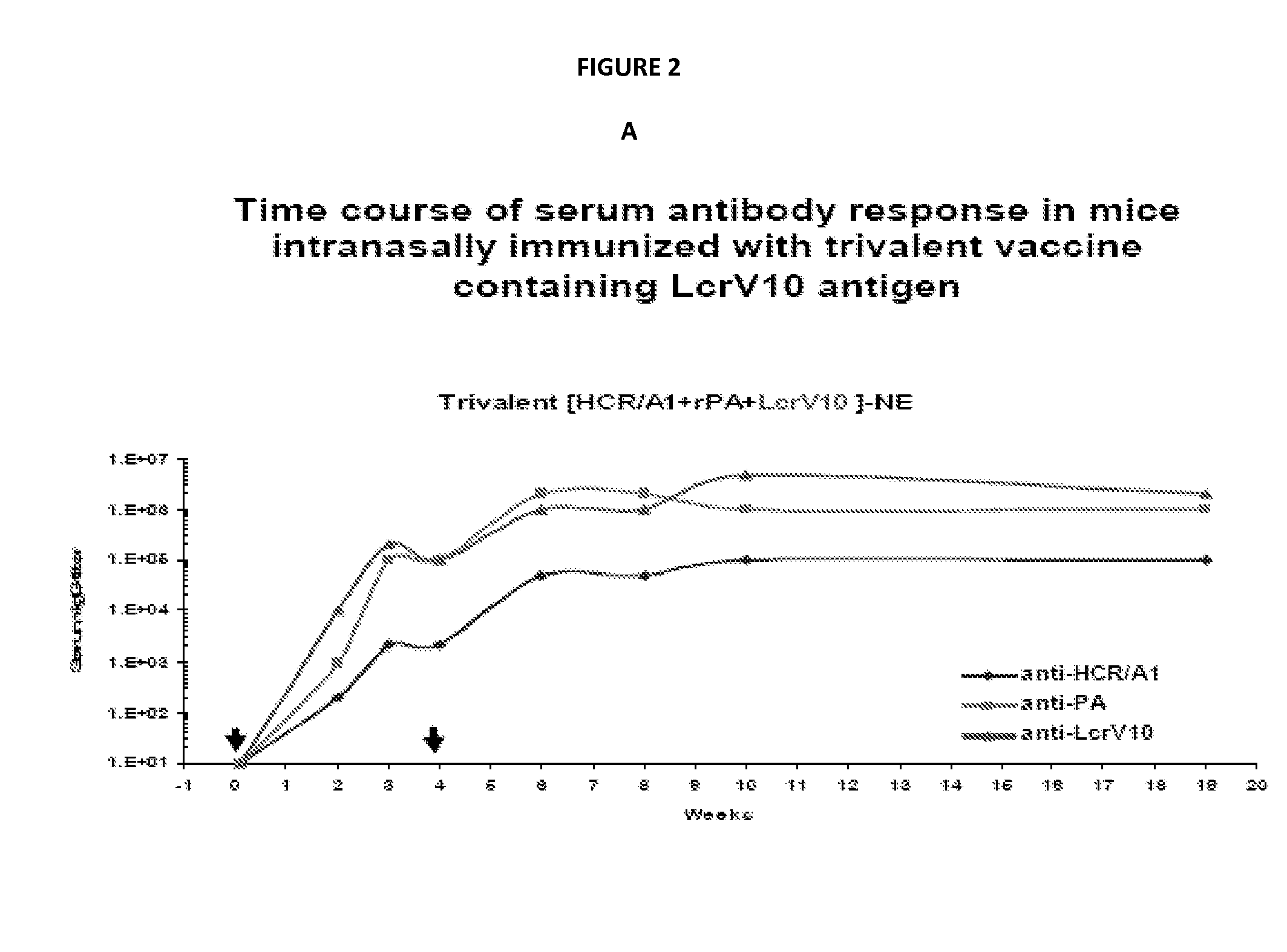Multivalent nanoemulsion vaccines
a nano-emulsion and vaccine technology, applied in the field of multi-valent nano-emulsion vaccines, can solve the problems of ineffective current vaccine delivery system for a broad spectrum of diseases, inability to repeat immunizations, and inability to detect and treat infectious diseases, so as to improve the spleen cellularity, reduce the risk, and increase the expression of ifn-.
- Summary
- Abstract
- Description
- Claims
- Application Information
AI Technical Summary
Benefits of technology
Problems solved by technology
Method used
Image
Examples
example 1
Compositions Comprising a Trivalent Nanoemulsion-Based Vaccine Against Bacillus Anthracis, Yersinia Pestis, and Clostridium botulinum and Methods of Using the Same
[0306]Materials and Methods
[0307]Vaccination. Anesthetized CD-1 mice were immunized with two nasal administrations of either monovalent or with a trivalent vaccine composed of the combination of recombinant proteins (20 μg of each antigen): PA (protective antigen) of Bacillus anthracis, rLcrV (or LcrV10) protein of Yersinia. pestis and rHCR / A1 (fragment of Clostridium botulinum neurotoxin) mixed with 20% W805EC (10 ul). Control immunizations were performed with antigens suspended in PBS, or with intramuscular injection of antigens adsorbed onto aluminum hydroxide adjuvant (alum, 0.5 μg / ml, 50 ul).
[0308]Antibody response. To analyze humoral immunity, serum samples were collected at 2-4 weeks intervals over a course of time. Bronchoalveolar lavage fluid (BAL), spleen and cardiac blood were collected at the termination of ani...
example 2
Characterization of Immune Response from Trivalent Nanoemulsion-Based Mucosal Vaccine Against Bacillus anthracis, Yersinia Pestis, and Clostridium botulinum
[0312]The immunogenicity of trivalent vaccines against HCR / A1, PA and either full length LcrV protein (See FIG. 1A) or truncated LcrV10 protein (See FIG. 1B) mixed with NE were tested by the analysis of antigen-specific serum IgG in immunized mice.
[0313]Development of immune response after nasal immunization with trivalent vaccine composed of PA / HCR / A1 and full length LcrV protein in shown in FIG. 2. Single intranasal (IN) immunization produced rapid and significant IgG response to all antigens. The anti-HCR / A1 response was 10 to 15 fold lower than PA and LcrV antigens. After boost the IgG levels reached over 106 titers which were sustained for 5 months without significant decrease in antibody levels. Immunizations with antigens in PBS (without combining with nanoemulsion) did not produce detectable immune responses.
[0314]Develo...
PUM
| Property | Measurement | Unit |
|---|---|---|
| diameter | aaaaa | aaaaa |
| diameter | aaaaa | aaaaa |
| pH | aaaaa | aaaaa |
Abstract
Description
Claims
Application Information
 Login to View More
Login to View More - R&D
- Intellectual Property
- Life Sciences
- Materials
- Tech Scout
- Unparalleled Data Quality
- Higher Quality Content
- 60% Fewer Hallucinations
Browse by: Latest US Patents, China's latest patents, Technical Efficacy Thesaurus, Application Domain, Technology Topic, Popular Technical Reports.
© 2025 PatSnap. All rights reserved.Legal|Privacy policy|Modern Slavery Act Transparency Statement|Sitemap|About US| Contact US: help@patsnap.com



